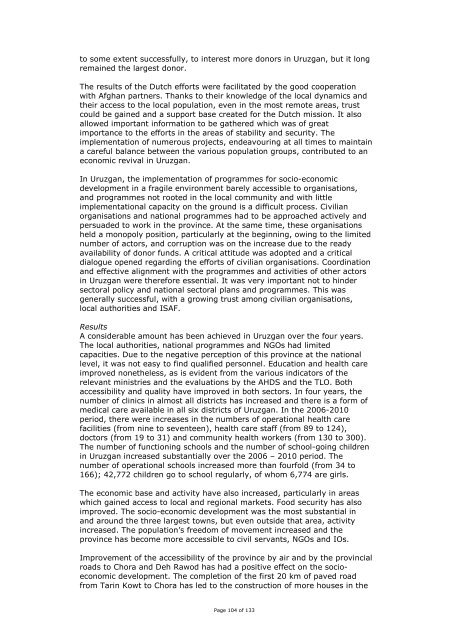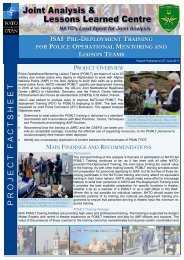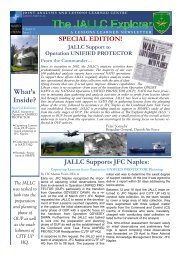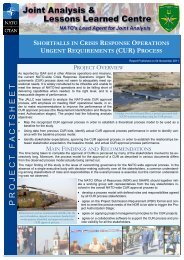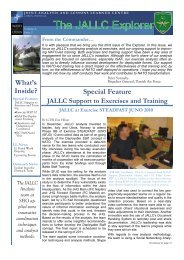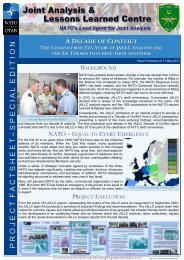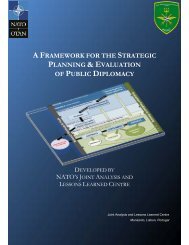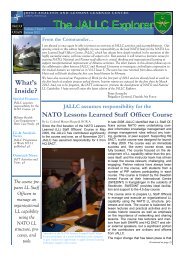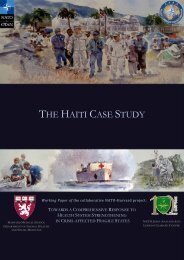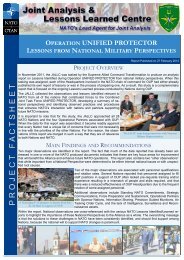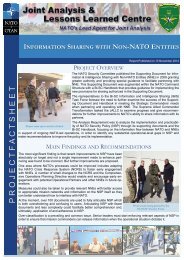to some extent successfully, to <strong>in</strong>terest more donors <strong>in</strong> Uruzgan, but it longrema<strong>in</strong>ed the largest donor.The results of the Dutch efforts were facilitated by the good cooperationwith Afghan partners. Thanks to their knowledge of the local dynamics andtheir access to the local population, even <strong>in</strong> the most remote areas, trustcould be ga<strong>in</strong>ed and a support base created for the Dutch mission. It alsoallowed important <strong>in</strong>formation to be gathered which was of greatimportance to the efforts <strong>in</strong> the areas of stability and security. Theimplementation of numerous projects, endeavour<strong>in</strong>g at all times to ma<strong>in</strong>ta<strong>in</strong>a careful balance between the various population groups, contributed to aneconomic revival <strong>in</strong> Uruzgan.In Uruzgan, the implementation of programmes for socio-economicdevelopment <strong>in</strong> a fragile environment barely accessible to organisations,and programmes not rooted <strong>in</strong> the local community and with littleimplementational capacity on the ground is a difficult process. Civilianorganisations and national programmes had to be approached actively andpersuaded to work <strong>in</strong> the prov<strong>in</strong>ce. At the same time, these organisationsheld a monopoly position, particularly at the beg<strong>in</strong>n<strong>in</strong>g, ow<strong>in</strong>g to the limitednumber of actors, and corruption was on the <strong>in</strong>crease due to the readyavailability of donor funds. A critical attitude was adopted and a criticaldialogue opened regard<strong>in</strong>g the efforts of civilian organisations. Coord<strong>in</strong>ationand effective alignment with the programmes and activities of other actors<strong>in</strong> Uruzgan were therefore essential. It was very important not to h<strong>in</strong>dersectoral policy and national sectoral plans and programmes. This wasgenerally successful, with a grow<strong>in</strong>g trust among civilian organisations,local authorities and <strong>ISAF</strong>.ResultsA considerable amount has been achieved <strong>in</strong> Uruzgan over the four years.The local authorities, national programmes and NGOs had limitedcapacities. Due to the negative perception of this prov<strong>in</strong>ce at the nationallevel, it was not easy to f<strong>in</strong>d qualified personnel. Education and health careimproved nonetheless, as is evident from the various <strong>in</strong>dicators of therelevant m<strong>in</strong>istries and the <strong>evaluation</strong>s by the AHDS and the TLO. Bothaccessibility and quality have improved <strong>in</strong> both sectors. In four years, thenumber of cl<strong>in</strong>ics <strong>in</strong> almost all districts has <strong>in</strong>creased and there is a form ofmedical care available <strong>in</strong> all six districts of Uruzgan. In the <strong>2006</strong>-<strong>2010</strong>period, there were <strong>in</strong>creases <strong>in</strong> the numbers of operational health carefacilities (from n<strong>in</strong>e to seventeen), health care staff (from 89 to 124),doctors (from 19 to 31) and community health workers (from 130 to 300).The number of function<strong>in</strong>g schools and the number of school-go<strong>in</strong>g children<strong>in</strong> Uruzgan <strong>in</strong>creased substantially over the <strong>2006</strong> – <strong>2010</strong> period. Thenumber of operational schools <strong>in</strong>creased more than fourfold (from 34 to166); 42,772 children go to school regularly, of whom 6,774 are girls.The economic base and activity have also <strong>in</strong>creased, particularly <strong>in</strong> areaswhich ga<strong>in</strong>ed access to local and regional markets. Food security has alsoimproved. The socio-economic development was the most substantial <strong>in</strong>and around the three largest towns, but even outside that area, activity<strong>in</strong>creased. The population’s freedom of movement <strong>in</strong>creased and theprov<strong>in</strong>ce has become more accessible to civil servants, NGOs and IOs.Improvement of the accessibility of the prov<strong>in</strong>ce by air and by the prov<strong>in</strong>cialroads to Chora and Deh Rawod has had a positive effect on the socioeconomicdevelopment. The completion of the first 20 km of paved roadfrom Tar<strong>in</strong> Kowt to Chora has led to the construction of more houses <strong>in</strong> thePage 104 of 133
area, <strong>in</strong>creased sales of agricultural products and quicker access to thehospital <strong>in</strong> Tar<strong>in</strong> Kowt. The accessibility of the prov<strong>in</strong>ce has also improvedthanks to expansion of the telephone, radio and television networks. Thereis now also access to f<strong>in</strong>ancial services. As a result of the improved securityand the <strong>in</strong>crease <strong>in</strong> the population’s purchas<strong>in</strong>g power, the number ofbus<strong>in</strong>esses at the Tar<strong>in</strong> Kowt bazaar has <strong>in</strong>creased from 900 to more than2,000, and there is much more money <strong>in</strong> circulation. Two banks haveopened branches <strong>in</strong> Tar<strong>in</strong> Kowt. Coord<strong>in</strong>ation and monitor<strong>in</strong>g of the variousactivities cont<strong>in</strong>ued to require attention due to the fragility of the area.The ultimate goal was to br<strong>in</strong>g about Afghan authorities which would beable to govern the prov<strong>in</strong>ce and provide the population with basic facilities<strong>in</strong>dependently. It was therefore important to have the progress <strong>in</strong> Uruzganborne by the local government. The population had to be conv<strong>in</strong>ced thattheir own prov<strong>in</strong>cial adm<strong>in</strong>istration was there for them and that noteveryth<strong>in</strong>g was be<strong>in</strong>g done for them by foreign experts and contractors. Forthe purpose of socio-economic development, this approach generallyworked well, although the limited implementational capacity at timesslowed progress and, accord<strong>in</strong>g to the TLO, the population ma<strong>in</strong>ly ascribedthe progress to the <strong>in</strong>ternational efforts and not to those of their ownauthorities.The Dutch contribution to the socio-economic development will cont<strong>in</strong>ueuntil 2014, which will allow the achievements to be consolidated. Someprojects are only now properly bear<strong>in</strong>g fruit, such as the road from Tar<strong>in</strong>Kowt to Chora. The <strong>Netherlands</strong> has strong partners <strong>in</strong> AusAid, USAID andGIZ for its activities <strong>in</strong> Uruzgan up to 2014. The sectoral programmes of them<strong>in</strong>istries of Education, Health Care, Rural Development, Agriculture andLocal Government will also cont<strong>in</strong>ue. The mission has laid a foundation fordevelopment, opened up the prov<strong>in</strong>ce to the outside world and managed to<strong>in</strong>terest an extensive network of actors <strong>in</strong> this prov<strong>in</strong>ce.6.2.6 Sub-conclusion: The 3D approachThe Dutch <strong>participation</strong> <strong>in</strong> <strong>ISAF</strong> was characterised by the 3D approach(Defence, Diplomacy and Development). This <strong>in</strong>volves connect<strong>in</strong>g military,diplomatic and development efforts as much as possible and <strong>in</strong>tegrat<strong>in</strong>gthem where desirable and possible. Conscious decisions were made as towhat efforts were to be made <strong>in</strong> which context. This gradually, andnaturally, created shared responsibility and plann<strong>in</strong>g processes, with<strong>in</strong>dividual activities tak<strong>in</strong>g place with<strong>in</strong> a shared framework. This <strong>in</strong>creasedthe effectiveness of the Dutch effort dur<strong>in</strong>g the mission and became acharacteristic feature of it. By the same token, it was decided <strong>in</strong> 2008 thatthe mission would no longer be led by a military commander alone, but thatthis would be done together with a diplomat.The <strong>in</strong>tegration of activities was important <strong>in</strong> The Hague, too. Dur<strong>in</strong>g themission, the cooperation between the m<strong>in</strong>istries of Foreign Affairs andDefence cont<strong>in</strong>ued to develop. The specific tasks and responsibilities of thetwo m<strong>in</strong>istries rema<strong>in</strong>ed <strong>in</strong> place though. There was appreciation for eachother’s expertise and its added value for the mission. The mission enhancedthe cooperation between the two m<strong>in</strong>istries.It should be noted, however, that the comprehensive approach, <strong>in</strong> whichthe civilian and military elements of the mission have equal roles, was notalways clearly discernible to the public. One of the reasons for this was thefact that the Dutch contribution was part of <strong>ISAF</strong>, which is led by NATO.NATO made a po<strong>in</strong>t of propagat<strong>in</strong>g its lead<strong>in</strong>g role, and with it the militaryelements of the <strong>in</strong>ternational efforts. Compared with the military work, thePage 105 of 133
- Page 1 and 2:
Final evaluationNetherlands contrib
- Page 3 and 4:
High mountainsLow mountainsPlains a
- Page 5 and 6:
Table of ContentsDutch military per
- Page 7 and 8:
Dutch military personnel deceased i
- Page 9 and 10:
Page 9 of 133
- Page 11 and 12:
1 IntroductionThe government would,
- Page 13 and 14:
The structure of the final evaluati
- Page 15 and 16:
2 The international presence in Afg
- Page 17 and 18:
insurgents in, particularly, the ea
- Page 19 and 20:
3 Netherlands policy for participat
- Page 21 and 22:
Netherlands’ presence. Furthermor
- Page 23 and 24:
“The objectives of this stabilisa
- Page 25 and 26:
In December 2005, the Netherlands g
- Page 27 and 28:
The expectation is that meaningful
- Page 29 and 30:
3.6.2 Implementation of national pr
- Page 31 and 32:
4 Implementation of the mission and
- Page 33 and 34:
tasks to fulfil in the area of secu
- Page 35 and 36:
such as the Bushmaster, that was be
- Page 37 and 38:
Afghan partner unit, at all times o
- Page 39 and 40:
northern part of Deh Rawod in 2007.
- Page 41 and 42:
in large and small bases, while con
- Page 43 and 44:
previously thought and comprised a
- Page 45 and 46:
Apart from facilitating training an
- Page 47 and 48:
If operations in close proximity of
- Page 49 and 50:
As previously mentioned, the preven
- Page 51 and 52:
- Between 2006 and 2010, the number
- Page 53 and 54: government of Chora in January 2010
- Page 55 and 56: At the beginning of the Dutch missi
- Page 57 and 58: intermediary of TLO and political a
- Page 59 and 60: interest for filling judicial posit
- Page 61 and 62: During the Uruzgan mission, a great
- Page 63 and 64: structurally change governance in U
- Page 65 and 66: development programmes. Before the
- Page 67 and 68: also the way in which Afghans perce
- Page 69 and 70: tailored to the real needs of the p
- Page 71 and 72: Gizab had increased and there was a
- Page 73 and 74: The DCU programme devoted and still
- Page 75 and 76: purpose of these loans, cooperative
- Page 77 and 78: In view of the lack of enthusiasm a
- Page 79 and 80: 5 Expenditure for the mission and i
- Page 81 and 82: Overview of long-term expenditure a
- Page 83 and 84: expenditure related to the deployme
- Page 85 and 86: Multi-year expenditure, Foreign Aff
- Page 87 and 88: explosive ordnance disposal, armour
- Page 89 and 90: this situation as constraining, for
- Page 91 and 92: organised at a later stage. In addi
- Page 93 and 94: occupational social workers and the
- Page 95 and 96: Mercedes Benz terrain vehicle, the
- Page 97 and 98: 6 ConclusionsThis chapter begins wi
- Page 99 and 100: The first part of the central quest
- Page 101 and 102: At the end of 2005, the Afghan auth
- Page 103: province. This, too, was done by me
- Page 107 and 108: ISAF and the OEF led to extra coord
- Page 109 and 110: d. The recommendations from advisor
- Page 111 and 112: Page 111 of 133
- Page 113 and 114: Annex A, Afghanistan Compact Benchm
- Page 115 and 116: end-2010, reforms will strengthen t
- Page 117 and 118: Afghan Cultural HeritageA comprehen
- Page 119 and 120: Private Sector Development and Trad
- Page 121 and 122: Annex B, Results of the socio-econo
- Page 123 and 124: EducationTLO data:• In 2006 there
- Page 125 and 126: Overview of the number of children
- Page 127 and 128: Annex C, Chronology200522 December:
- Page 129 and 130: July: microcredit provider World Co
- Page 131 and 132: Annex D, List of abbreviations3DADZ
- Page 133: Page 133 of 133


